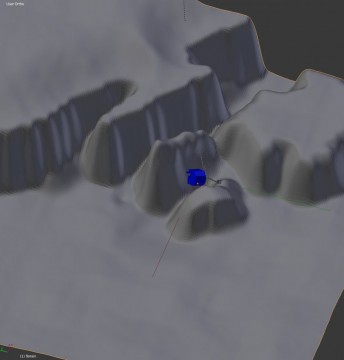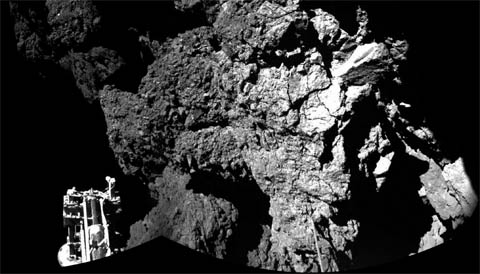The exact location of Philae’s landing site remains unknown, though the site’s topography might allow the lander to operate longer than planned. Meanwhile, Rosetta is detecting organics and heavy elements even when Comet Churyumov-Gerasimenko is far from the Sun.
The Rosetta mission continues to return startling results from Comet 67P/Churyumov-Gerasimenko, as its team reported during the American Geophysical Union (AGU) fall conference in San Francisco last week. Their reports build upon the announcement, earlier this month that a key isotopic ratio in 67P’s water vapor is very dissimilar to Earth’s, implying that our water likely did not come from comets.

Philae’s touchdown in early November marked the first time a spacecraft had soft-landed on a comet. “Never before have we landed on such an ancient object,” says Jean-Pierre Bibring (Institut d’Astrophysique Spatiale, Orsay, France). The comet is old enough, and pristine enough, to provide a frozen snapshot of the early solar system’s composition — just one reason Philae and Rosetta traveled for 10 years to reach it.
When the main craft prepared to drop off Philae, the density of gas measured by Rosetta Orbiter Spectrometer for Ion and Neutral Analysis (ROSINA) oscillatory changes with periods of about 12 or 4 hours. This was very surprising until scientists factored in the rotation of the strangely shaped nucleus (better visualized in a December 19 video) and its two distinct hemispheres, explains Kathrin Altwegg, ROSINA’s principal investigator.
Along with sensing the comet’s now-iconic silhouette, ROSINA detected an array of heavy elements and organics, some with molecular masses higher than 60. “The comet surprises us nearly every day with new results,” says Altwegg. Specifically, ROSINA has detected methanol (CH3OH), formaldehyde (CH2O), ammonia (NH3), and cyanide (CN) to name a few. “The comet stinks,” jokes Altwegg. The team did not expect to detect these compounds in the coma with the comet still so far from the Sun.
Altwegg stresses that ROSINA cannot yet confirm that the two hemi-ducks (“they aren’t spheres,” she says) are of distinct and different compositions. Such a confirmation would imply that the odd shape resulted from the bonding of two different space rocks.
For now, the comet is quiescent and has released little gas since August 2014. However, a hundredfold increase in activity is expected by next August, as the nucleus sails closer perihelion. ROSINA is expected to operate through 2015.
While Rosetta is still observing and measuring from orbit, Philae slipped into hibernation a month ago when its power ran out. After its bumpy landing, the team doesn’t know exactly where Philae sits on the comet’s surface. But the three-legged, washing machine-sized lander sent back a few images of where it was and data from all 10 of its instruments prior to hibernation.
The team executed an intensive photographic search as recently as December 6th, when Rosetta was relatively close to the surface, but the lander was in shadow. Three more searches are scheduled and OSIRIS Principal Investigator, Holger Sierks (Max Planck Institute), postulates they’ll find the lander in those images. Only the download time is holding up investigation as “data is first come first serve,” says Sierks.

Credits: ESA/Rosetta/Philae/CIVA
The patchwork view Philae set back of its new home shows the lander to be sitting in hole, surrounded by a number of cliffs. This is a good thing, as the science team believes these cliffs and their shadows could act as a shield against the extreme environment caused by when the comet surges to life near perihelion. One cliff, “The Perihelion Cliff,” as dubbed by Bibring, showcases layers of ice and dust and linear fracture patters and materials that could be loaded with pristine organics. “This was the material we were desperately looking for.”
Exasperation over the wait for the lander to come back online (which could occur weeks or months) is balanced by the thought of extended operating time. “If we are lucky enough and robust enough — and I think we are both — we can go beyond the expectation” of this mission, said Bibring.
However, the steep incline shortens the amount of sunlight reaching Philae’s solar panels to only 4½ hours during each 12½ rotation. Now that the main battery on board has been depleted (designed to last 64 hours), the instruments are getting power from a second battery that is recharged by solar cells on Philae’s exterior. Reduced sunlight can seriously reduce the exploratory capacity of the lander’s instruments. But the team is confident that Philae will again power up. Bibring notes that the wake up only requires 15 to 20 watts.
Big events are expected in the year ahead. The team is preparing Rosetta for a series for flybys and close encounters before the comet gets too active during its solar approach. One set for mid-February will get the craft within 10 km of the cometary surface. Rosetta will also try to fly through a jet close to perihelion in July 2015. Getting there will require a series of boxy orbits and sharp directional adjustments to swing in and out of the jet without being blown away, but getting about 50 km from the nucleus. Ultimately, the science team hopes to extend the mission into 2016, if fuel reserves and other conditions permit.
For backstory on Rosetta's voyage, read the August 2014 issue of Sky & Telescope.
 0
0









Comments
You must be logged in to post a comment.